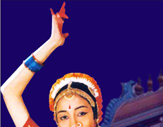 |
 |
 |
 |
| Classical Dances |
"Whither the hand goes, the glance follows, |
Bharatnatyam Bharatanatyam is one of the oldest dance forms in India. A popular interpretation of the name of the style is: BHAva (expression) + RAga (musical mode) + TAla (rhythm) NATYAM (dance) = BHARATA NATYAM Bharata Natyam, which originates from the state of Tamil Nadu in South India, It is a combination of the arts of the stage: music, color, rhythm and poetry. The dance derives its technique from the treatise, Natya Sastra, written by Sage Bharata. It was nurtured in the temples and courts of Southern India since ancient times. This dance is classified into nritta or pure dance and abhinaya or portrayal of feelings. If nritta or pure dance is the body of dance, abhinaya maybe called its soul.Abhinaya is of 4 kinds. |
|
Abhinaya may be rendered through Loka Dharmi, conforming to what exists in the world or Natya Dharmi, the ideal to be followed as laid down in the treatises on the dance. Today, Degree and Postgraduate courses covering the practice and theory of Bharatanatyam as well as the languages associated with its development are available at major universities of India. |
|